A Moment of Weakness
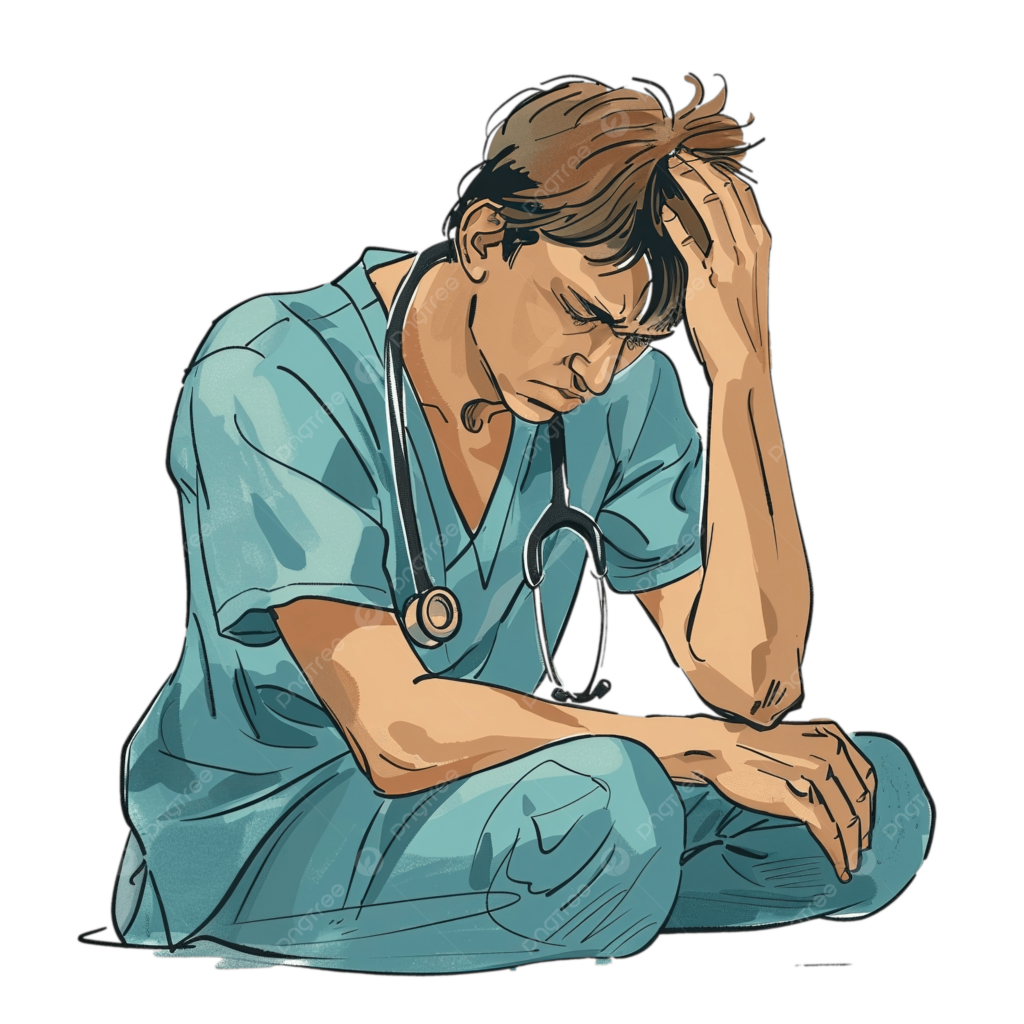
Young healthcare professionals inevitably face the death of a patient early in their careers, a moment that challenges both their emotional resilience. While some are deeply affected, others cope differently, yet all must navigate this reality and continue providing compassionate care. This poignant poem by final-year medical student Kashaf Naveed captures the emotional turmoil of losing a first patient, highlighting the balance between empathy and strength that defines the medical profession. Through vivid imagery and raw emotions, it pays tribute to the dedication of healthcare workers who persevere despite the weight of loss. Being a curer, I believed in my ability Keeping in mind, shouldn’t lose my humility Being guided by oath I swore to treat The patients who were desperately in need I walked in my ward for the first time Being bold and courageous, soft and kind Ailing patients on beds, with paling eyes Some were numbing, distressing and profound cries Still there was one with ventilator but eyes gleaming his hope, will and confidence not failing He held my hands enduringly with trust His milky face, hoping me to do what I must Applying all the wisdom and acumen I acquired the best ways of medication I tried But after some days, grimed with grief and sin I remember losing first patient of mine The moment of weakness I came across I was mourning over the terrible loss
Shalamar Hospital Achieves ISO 9001:2015 Certification: A Milestone in Quality Healthcare
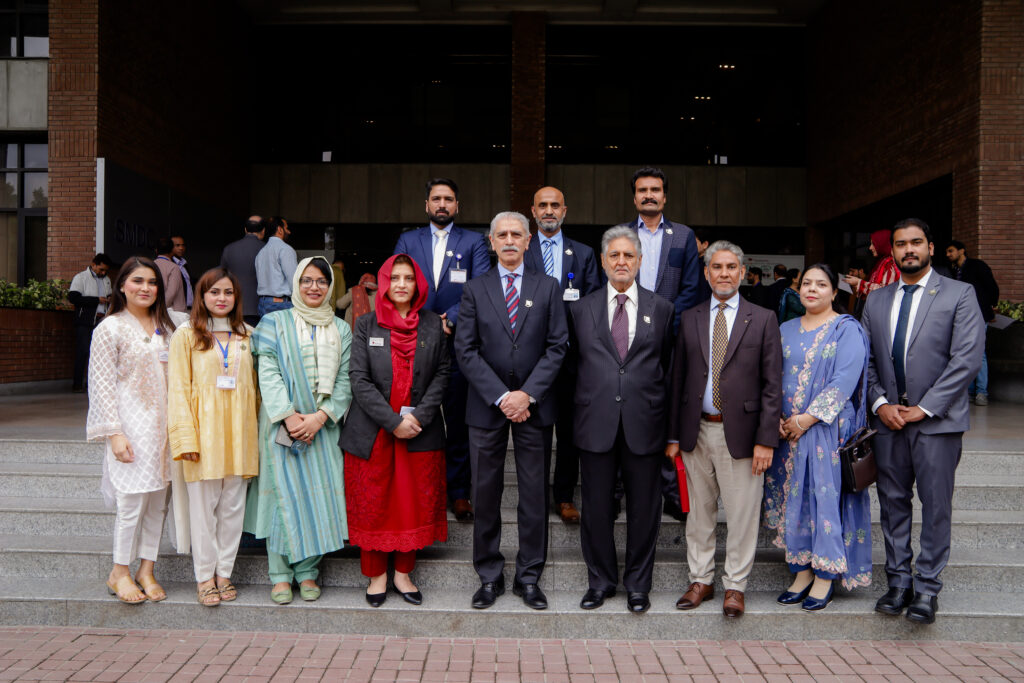
Quality and patient safety are at the heart of any healthcare organization’s mission. At Shalamar Hospital, we have always strived to enhance our processes, improve patient care, and ensure continuous quality improvement. Today, we proudly announce a major achievement: Shalamar Hospital has successfully obtained ISO 9001:2015 certification—a globally recognized standard for quality management systems (QMS). Why ISO 9001:2015 Certification Matters in Healthcare ISO 9001:2015 is an internationally acclaimed standard that sets the criteria for a robust quality management system. It focuses on customer satisfaction, risk-based thinking, process optimization, and continual improvement. In a healthcare setting, this certification translates into structured processes, enhanced patient safety, and improved service delivery. For hospitals, ISO 9001:2015 certification ensures: ✔ Standardized quality management processes ✔ Increased efficiency and reduced errors ✔ Enhanced patient experience and satisfaction ✔ Stronger regulatory compliance ✔ A culture of continuous improvement The Journey Towards ISO 9001:2015 Certification Achieving this certification was not an overnight success but a journey of dedication, collaboration, and perseverance. The process involved multiple phases, including: Gap Analysis & Planning: Assessing our existing processes against ISO 9001:2015 requirements and identifying areas for improvement. Process Standardization & Documentation: Implementing standardized policies and procedures for various departments, ensuring consistency in operations. Training & Awareness: Conducting training sessions for staff to enhance their understanding of quality management principles and their role in compliance. Internal Audits & Risk Management: Performing rigorous internal audits to identify gaps, mitigate risks, and address non-conformities. Management Review Meetings (MRMs): Engaging leadership in reviewing progress and making data-driven decisions. Stage 1 & Stage 2 Certification Audits: Undergoing extensive external audits by certification bodies to validate compliance with ISO 9001:2015 standards. Overcoming Challenges Like any transformational journey, our path to ISO certification came with challenges. One of the major hurdles was embedding a culture of quality across diverse clinical and non-clinical departments. Resistance to change, ensuring documentation compliance, and aligning staff with quality objectives required continuous engagement and education. Through strong leadership commitment and teamwork, we overcame these obstacles, fostering a culture where quality is everyone’s responsibility. What This Means for Our Patients and Staff ISO 9001:2015 certification is more than just a recognition—it is a commitment to maintaining and exceeding quality standards in healthcare delivery. For our patients, this means: ✅ More streamlined and reliable processes ✅ Safer healthcare practices ✅ Improved patient satisfaction ✅ Confidence in receiving high-quality care For our staff, this certification reinforces: ✅ A structured and efficient work environment ✅ Clear guidelines and accountability Opportunities for continuous learning and professional growth Looking Ahead: Continuous Quality Improvement While we celebrate this milestone, we recognize that the journey of quality improvement never ends. We remain committed to continuously enhancing our systems, embracing innovation, and adapting to evolving healthcare challenges. Our focus will remain on patient-centered care, data-driven decision-making, and fostering a culture of excellence. A Heartfelt Thank You This achievement would not have been possible without the dedication of our quality improvement team, leadership, healthcare professionals, and support staff. Every department played a crucial role in making this a reality. Your hard work and commitment to excellence have made this certification possible! As we move forward, we invite collaboration, learning, and shared best practices to uphold the highest quality standards in healthcare.
Shalamar Nursing College Achieves 100% Results in UHS Annual Examination 2023
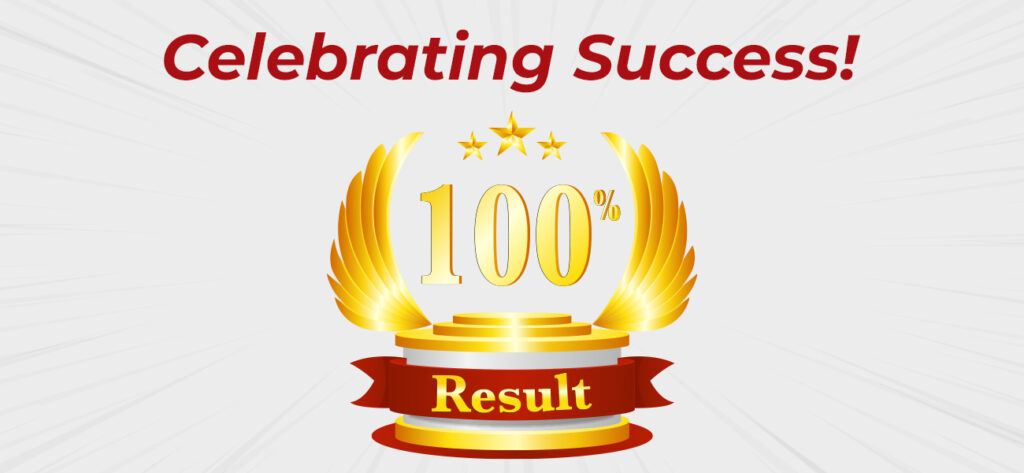
We are thrilled to announce the exceptional performance of Shalamar Nursing College in the First Professional B.Sc. Nursing (4 years) UHS annual examination 2023. The result of exams, held from March to April 2024, have been released, and we are proud to share that our college has achieved a remarkable 100% pass rate. This outstanding achievement sets Shalamar Nursing College apart as the only private institution among 73 colleges to reach this significant milestone. Our students’ dedication and hard work, combined with our faculty’s unwavering commitment to excellence, have made this success possible. Congratulations to all our students and staff for their exceptional efforts and dedication. This accomplishment reflects our college’s high standards and commitment to nurturing future nursing professionals.
Celebrating the Inaugural Cohort of the Medical Enrichment Program
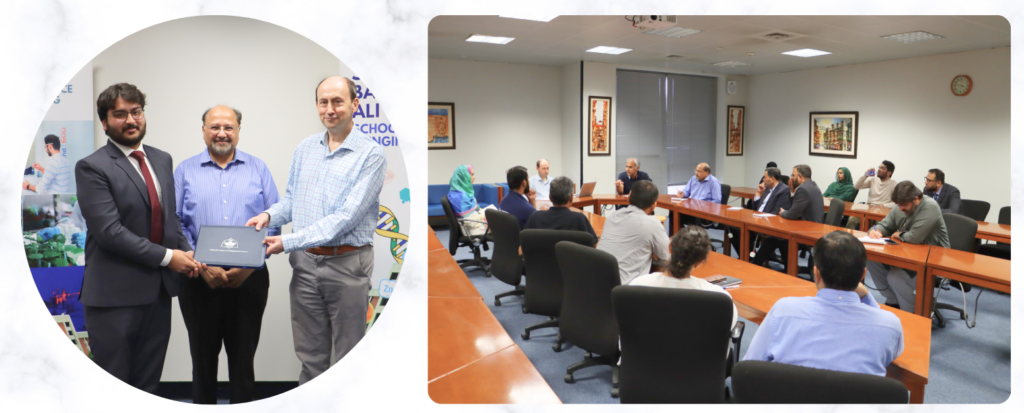
Shalamar Medical & Dental College (SMDC) and the Syed Babar Ali School of Science and Engineering (SBASSE) at Lahore University of Management Sciences (LUMS) are thrilled to announce the successful completion of their first-ever cohort of Medical Enrichment Program. This intensive one-year program, launched in Spring 2023 allows SMDC MBBS students to study for one year at LUMS. The program is designed to elevate the quality of medical education in the country. The inaugural cohort completed this program with the generous support of the Shahid Hussain Foundation. The inaugural cohort of students, including Ali Asim, Zuha Bilal, Aalian Ubaid, and Muhammad Anas, received their certificates and transcripts at a special ceremony. Dignitaries from both institutions, including Dr. Walther (Dean of SBASSE) and Prof. M. Zahid (Principal of SMDC), presented the certificates, signifying the strong collaboration and shared vision for advancing medical education. Dr. Muhammad Tariq Professor at the Department of Biology spoke about the students’ achievements and the program’s potential for future development. Students also shared their experiences and valuable insights through a feedback session. The ceremony culminated in a heartwarming recognition of the students’ dedication and the program’s success. Both institutions pledged their continued commitment to excellence in medical education, ensuring a bright future for the program and its graduates.
Shalamar Medical and Dental College Ranked Top Medical College
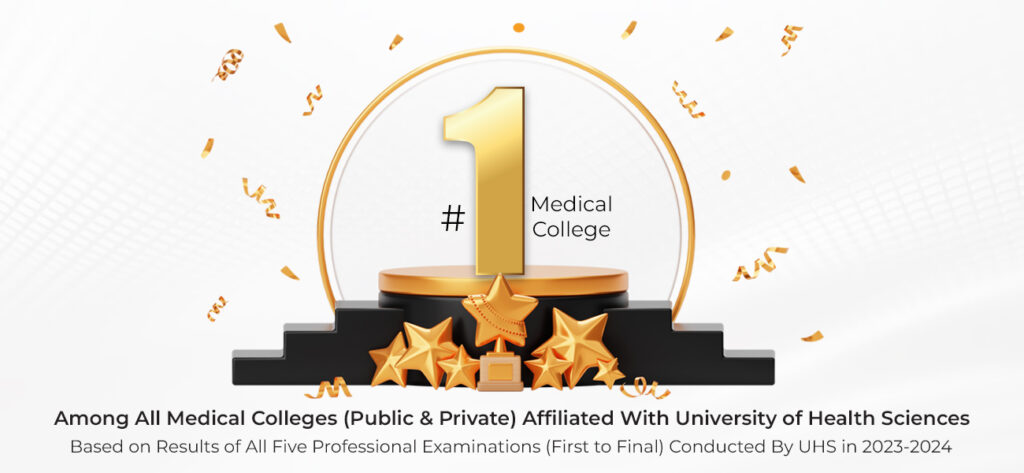
Shalamar Medical and Dental College is ecstatic to announce its achievement of the coveted #1 ranking among all medical colleges, both public and private, affiliated with the University of Health Sciences (UHS). This incredible feat is a culmination of the combined results from five professional examinations conducted in 2023. The unwavering dedication of our exceptional faculty, the relentless hard work of our students, and the unwavering support of our entire community all proved instrumental in securing this remarkable success. For a closer look at performance, students excelled across all year groups: final year (93.92), fourth year (96.38), third year (95.00), second year (98.55), and first year (99.28), resulting in an impressive overall mean score of 96.6254 and solidifying our position at the #1 spot. While we bask in the glory of this achievement, Shalamar Medical & Dental College remains firmly committed to a path of continuous improvement. We strive for excellence in everything we do. Let’s leverage this success as motivation to propel ourselves to even greater heights, together!
2nd Shalamar IRC RCOG Summit 2025
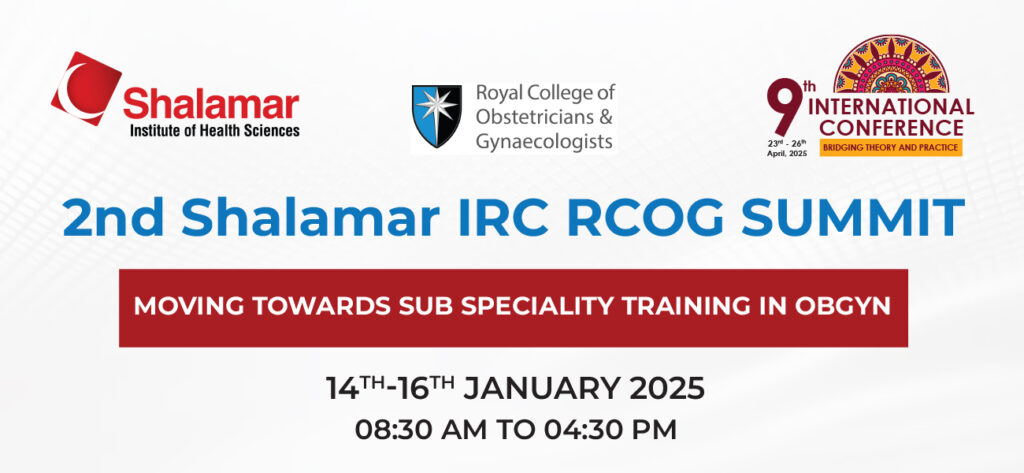
Building on the triumph of our inaugural summit, we are proud to continue the legacy of excellence. The 1st Shalamar IRC RCOG Summit set a benchmark for impactful discussions, fruitful collaborations, and knowledge exchange. As we embark on the 2nd edition, we are committed to surpassing previous achievements and fostering an even more enriching experience. Join us for the 2nd Shalamar IRC RCOG Summit, happening from January January 14th to 16th, 2025, Spearheaded by the esteemed Prof. Dr. Nazli Hameed, this summit promises an exceptional platform for participants to engage with international subspecialist experts, fostering invaluable networking and collaboration opportunities. Thematic Focus: Embark on a journey through cutting-edge themes across three insightful days: Day 1: Urogynaecology & Minimal Access Surgery Delve into the latest advancements and techniques in urogynaecology and minimal access surgery, gaining insights from leading practitioners in the field. Day 2: Reproductive Medicine & Gynae-Oncology Explore breakthroughs in reproductive medicine and maternal medicine, uncovering strategies to enhance patient care and outcomes. Day 3: Fetal Medicine, Maternal Medicine & Artificial Intelligence Navigate through the realms of fetal medicine and gynae-oncology, discovering innovative approaches to diagnosis, treatment, and care. Call for Abstract Submission: We invite Scholars, Researchers, and Practitioners to contribute abstracts aligning with the summit’s themes. The deadline for abstract submission is September 30th, 2024. Seize this opportunity to showcase your work and contribute to the discourse shaping the future of women’s health. Guest of Honour: Ranee Thakar (President RCOG) Kate Lancaster (CEO RCOG) Awards for Papers & Posters: 1st Prize: Gold Medal 2nd Prize: Silver Medal 3rd Prize: Bronze Medal Pre-Conference Workshop: Topic: Safe Clinical Practices (Human Factors & PPH Bundle) Date: January 13th, 2025 Time: 8:30 AM to 4:30 PM Registration Fee Early Bird Registration By 30-9-2024 Foreign Consultants $50 Pakistani Consultants PKR 15,000 Residents/Trainees PKR 5000 Regular Registration Foreign Consultants $65 Pakistani Consultants PKR 20,000 Residents/Trainees PKR 7,500 On- Site registration Foreign Consultants $75 Pakistani Consultants PKR 25,000 Residents/Trainees PKR 10,000 For Abstract Submission: Kindly Contact [Dr. Rabia Mushtaq WhatsApp 0044-7523862202 Email dr.rabiaamer@gmail.com] For Inquiries Kindly Contact: [Dr. Areefa Khan 0092 322-7050983, Email: areefakhan14@gmail.com ] [Dr. Sania Imran 0092 331-4627666, Email: saniaimran123@gmail.com ] 2nd Shalamar IRC RCOG Summit 2025 Videos 6 Videos 🎓 2nd Shalamar IRC RCOG Summit | Prof. Zahid Bashir, Principal, Shalamar Medical and Dental College 1:14 🎓 2nd Shalamar IRC RCOG Summit | Prof. M. Samee Akhtar, Senior FRCOG. 1:40 🎓 2nd Shalamar IRC RCOG Summit | Ranee Thakar, President (RCOG), UK 2:26 2nd Shalamar IRC RCOG Summit | Kate Lancaster, CEO, RCOG, United Kingdom 2:11 2nd Shalamar IRC RCOG Summit | Prof. Dr. Rashid Latif Khan, Former Chair IRC RCOG, Pakistan. 2:00 2nd Shalamar IRC RCOG Summit | Sonia Naqvi, Fellow IRC RCOG, Pakistan 0:59
8th International Conference at SMDC
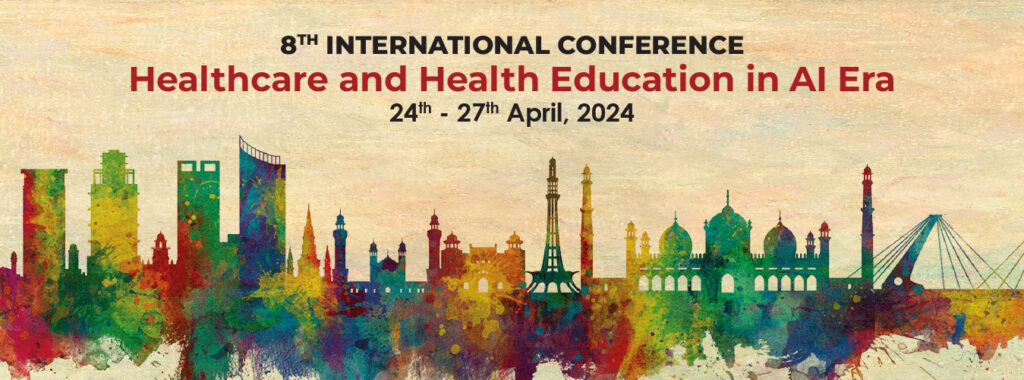
Shalamar Institute of Health Sciences proudly inaugurated its 8th International Conference, bringing together esteemed medical professionals, scholars, and researchers from across Pakistan and beyond. Themed “Healthcare & Health Education in the AI Era,” conference aims to delve into the transformative impact of artificial intelligence on healthcare delivery and medical education. Distinguished guests including, Chairman of the Board of Trustees of Businessmen Hospital Trust Mr. Shahid Hussain, Prof. Dr. Zahid Bashir, Principal of Shalamar Medical & Dental College, and Dr. Ayesha Nauman, COO of Shalamar Hospital, graced the occasion along with faculty members and senior doctors. The conference witnessed active participation from doctors, surgeons, and medical professionals from various parts of Pakistan and abroad. Prof. Dr. Zahid Bashir extended a warm welcome to all attendees, setting the tone for a series of engaging discussions and activities. Live surgeries were conducted during the conference, showcasing advancements in medical technology and practice. Attendees had the opportunity to attend sessions and workshops covering a wide array of topics. Doctors specializing in different fields presented their latest research findings, fostering knowledge exchange and collaboration. Participants shared insights and perspectives on the evolving role of AI in shaping the future of healthcare. Speaking on the occasion, Mr. Shahid Hussain emphasized the significance of conferences and workshops in advancing medical knowledge and practice. He highlighted the longstanding commitment of Shalamar Institute of Health Sciences to promote medical research and education, as demonstrated by the continuation of the international conference for the past eight years. In addition, Prof. Dr. Zahid Bashir outlined the roadmap for various programs and initiatives at Shalamar Institute of Health Sciences for the upcoming year, reaffirming the institution’s dedication to excellence in healthcare education and service.
Physiotherapy’s Types and Practices

How many different types of physiotherapy are there? People of all ages can benefit from physiotherapy, which has the potential to be a life-changing experience. Some examples of different types of physiotherapy are as follows: Musculoskeletal Physiotherapy Musculoskeletal Physiotherapy or “orthopedic Manual therapy” focuses on restoring the musculoskeletal system’s functionality, which includes the muscles, joints, bones, ligaments, and tendons. It can improve mobility, lessen discomfort, treat injuries, and repair soft tissue damage. Gynecological Physiotherapy This branch of physiotherapy focuses on treating the female problems and other surrounding areas that are impacted by significant life events for women, such as pregnancy and childbirth. Neurological Physiotherapy The nervous system is affected by neurological conditions such as strokes, spinal cord injuries, Parkinson’s disease, multiple sclerosis, and brain injuries. Physical therapy is well known to help neurological patients in regaining their mobility and helps to stop other complications brought on by neurological issues. Cardiovascular Physiotherapy Cardiovascular physiotherapists assess your heart and lungs’ health and recommend the best activities. Asthma and excessive chest discharge are two disorders that can be treated with this type of therapy. Respiratory Physiotherapy This type of physiotherapy helps in improving the quality of life of patients with diseases such as cystic fibrosis, asthma, and chronic obstructive pulmonary disease. Sports Physiotherapy Sports activities are typically more physically taxing and athletes are more susceptible as a result of muscle and tendon injuries. Sports physiotherapists assist athletes in recovering more quickly from sports injuries and improving their overall performance. Pediatric Physiotherapy A subspecialty of physical therapy known as pediatric physiotherapy is dedicated to identifying, preventing, and treating developmental abnormalities in newborns, young children, and teenage patients. Geriatric Physiotherapy Although, age-related health complications such as muscle mass reduction, delayed reaction times, and imbalance are common. Fortunately, issues like loss of motion, arthritis, or Alzheimer’s disease can be addressed by geriatric physiotherapy. Physiotherapy from the comfort of your home! Home physical treatment is an option, but make sure you speak with your doctor first. Back exercises Lie on your back with both of your legs straight. In this position, bring your left knee up close to your chest. Hold this position for 10 seconds. Return your leg to the straight position. Repeat with the right leg. Stand up with your arms on your side. Bend to the left side while slowly sliding your left hand down your left leg. Come back up slowly and relax. Repeat with the right side of your body. Neck exercises Keep your eyes centered on one object directly in front of you, now slowly move your head back. You will now be looking at the roof. Keep your whole body still. Hold this position for 5 seconds and slowly return your head to the start position. Keep your eyes centered on one object directly in front of you, now slowly move your head down. You will now be looking at the floor. Keep your whole body still. Hold this position for 5 seconds and slowly return your head to the start position. Keep your eyes centered on one object directly in front of you, and turn your head to the left, and your vision should be in line with your left shoulder. Turn your head as far as you can and hold the position for 5 seconds. Slowly relax as you return your head to the start position. Foot exercises. First write digits 1 to 10 using your toes raised in the air. Sit on a chair, raise your toes, and curl them Pick up a small piece of cloth off the floor using your toes. Still in a sitting position, point your toes and circle your ankles in a slow counter and clockwise motion. Stand up from the sitting position and go on tip toe for 5 seconds. Link for exercises: https://sundialclinics.co.uk/treatments/physiotherapy/physiotherapy-exercises-you-can-do-at-home/ Written By: Jabeen Zahra – Intern, Shalamar Hospital
Physiotherapy: A Neglected Field
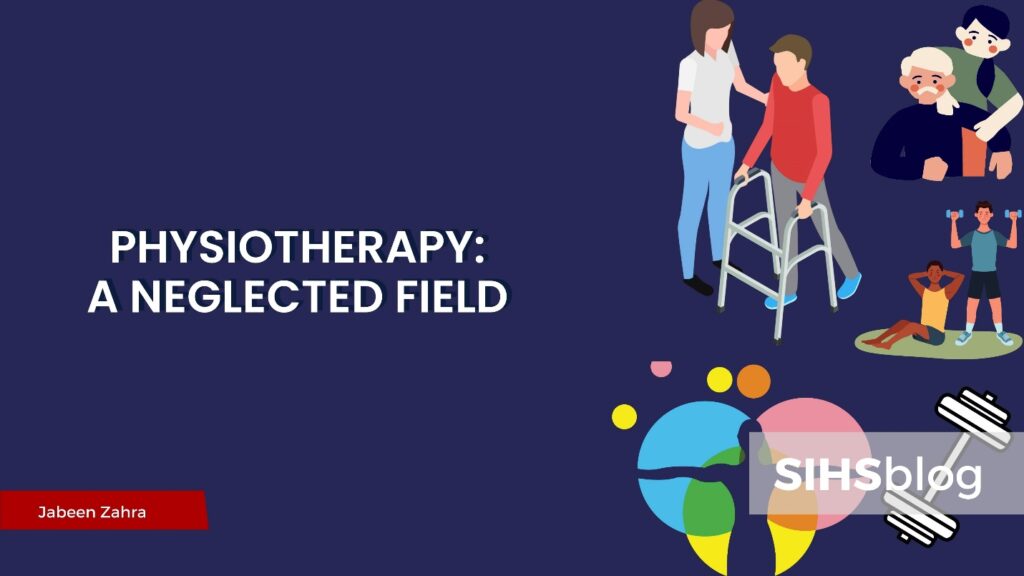
“Recovery is indeed a manifestation of the law of nature, efforts of patient and guidance from a physical therapist or rehabilitation specialist.” ― Joerg Teichmann Importance of Physical Therapy Physiotherapy increases a patient’s mobility, function, and general health. Through physical rehabilitation, injury prevention, and health and fitness, physiotherapy improves the quality of life of many patients. A physiotherapist can help you get on track to a pain-free life, which is necessary to engage in your favorite physical activities and ward off many chronic illnesses. However, even while surgery and medication are often recommended as the best treatments for specific ailments, there are other circumstances when physiotherapy can be just as successful. For example, lower back pain, evidence suggests that this problem is usually overtreated with imaging, prescription medications, and procedures, while early physical therapy can prove itself a very economical course of action. History of the Physiotherapy Hippocrates and Galen, two physicians, are thought to have introduced the science of physiotherapy as early as 400 BC when they encouraged the use of hydrotherapy, massage, and manual therapy techniques to treat their patients. However, during the First World War, physiotherapy became institutionalized, and women were hired to work with soldiers, offering physical treatment to assist repair the wounds they had sustained. The World Health Organization (WHO) helped the Federal Government, Ministry of Health & Social Welfare build the school of physiotherapy in 1956 in Jinnah Postgraduate Medical Center. To match the international standard, the four-year BSPT program was recently upgraded to a five-year DPT (Doctor of Physiotherapy) program in 2008. Problems with Physiotherapy in Pakistan The problem with physiotherapy in Pakistan is that although physical therapy has been practiced for almost 60 years, there is still no regulatory body for the oversight of physiotherapy degree programs and the registration of physiotherapists. Moreover, there is no set meritocracy when admitting students to Physiotherapy programs in universities all around Pakistan. Many educational institutions are not connected to hospitals, which prevent students from participating in clinical training or house jobs. As a result, they eventually join the hospital with degrees but no relevant work experience. If such a body is created, it will make sure that physiotherapy schools uphold their educational standards and that only licensed professionals are permitted to practice. The government must take special action to save this profession because the situation is getting worse by the hour. The federal and provincial governments should generate jobs. In addition to the government, I implore the media and civil society to emphasize the value and necessity of physiotherapy for the nation.
Breast Cancer: Symptoms and Self-examination

Every one in nine (1 in 9) women receives a breast cancer diagnosis during her lifetime; Pakistan has the highest disease incidence among all Asian countries. Therefore, it has become crucial to spread awareness among the general public to ensure early detection and save the precious lives of both men and women. Signs and Symptoms: Knowing any disease’s various signs and symptoms is essential because it marks the beginning of its detection process. However, it is crucial to understand that the symptoms of breast cancer can vary depending on its stage and type. Following are some of its common signs: Early breast cancer: A change in size and shape of the breast. Change in the appearance of the nipple. Nipple discharge (other than breast milk) Lumps or nodes that can be felt in or on the breast. Invasive breast cancer: Breast lump. Peeling of the nipple skin. Itchy breast. The breast is tender, warm, and/or hard to touch. Pitting the breast skin (like an orange: Peau d’orange appearance). Nipple retraction and discharge. ( later stage) Lump or swelling in the underarm lymph nodes. Inflammatory breast cancer: Heaviness and aching in the breast. Pitting of breast skin. Inverted nipple. The breast is red, itchy, and tender to the touch. Lump or swelling in the underarm lymph nodes. Metastatic breast cancer: If the lungs are affected: difficulty breathing, coughing, and chest pain. If the brain or spinal cord is affected: headache, seizures, pain, or blurry vision. If bones are affected: reduced alertness, pain, and fractures. If the liver is affected: nausea, fatigue, swelling, and jaundice. Male breast cancer: Symptoms experienced by men are similar to women, including: Painless lumps in the breast. Nipple discharge. Increase in size of the breast. Thickening of breast skin. Breast Self-examination: According to the John Hopkins Medical Centre, 40% of diagnosed breast cancers are detected by women who feel a lump, which emphasizes the significance of breast self-exams. Men and women should conduct the exam regularly because the condition, although uncommon in men, is just as fatal. How regularly should it be performed? It must be performed monthly, and the ideal time is between the 3rd and 5th day of your menstrual cycle or on the same day of every month for men (especially with a family history of breast cancer), post-menopausal women, or females with irregular menstrual cycles. Steps of the exam: Visual inspection: You must stand in front of a mirror with your breasts completely exposed and your hands by your sides. Look for any changes in breast shape, size, and color, as well as symmetry, skin dimpling and nipple retraction. Then raise your hands above your head and observe again. Finally, place your hands on your hips to flex your chest muscles and look for any changes. Make sure to observe and compare both breasts. Manual inspection while standing: For this procedure, you must use your right hand to examine your left breast and vice versa. You must use the pads of the 3 middle fingers of one hand to feel all parts of the breast in a circular motion. Also, apply different pressures and feel for any lumps or thickness. Then squeeze your nipple to check for discharge. Repeat this for the other breast. Manual inspection while lying down: For this step, first put a pillow under your right shoulder and flex your right arm. Then use the pads of the 3 middle fingers of your left hand to palpate your right breast and armpit. Repeat this procedure for the left breast and armpit. When to consult a doctor? If you find any of the aforementioned signs (lump, bloody nipple discharge, color change, or change in skin texture), make sure to visit your doctor so the underlying cause of the anomalies can be determined.
